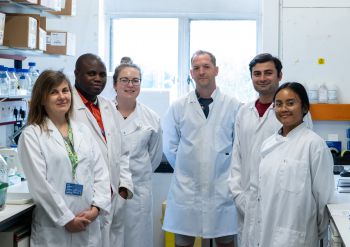
Dr Rhys Morgan (centre) surrounded by members of his lab, some of which co-authored the study
A discovery by researchers at the University of Sussex has the potential to benefit leukaemia patients by opening up new treatment strategies for treating the disease.
Acute myeloid leukaemia (AML) is an aggressive form of leukaemia which impacts a type of white blood cell (leukocyte) normally responsible for fighting infection and preventing tissue damage. There are around 3,000 new cases of AML in the UK annually, but the disease has a poor prognosis and high rates of relapse, as current chemotherapies are both highly toxic and ineffective.
But now, researchers have discovered that two major oncoproteins could be working together within leukaemia cells, impacting one another's oncogenic signalling activity – that is, their ability to alter genes and cause the development of a tumour.
Dr Rhys Morgan, Lecturer in Biomedical Science at the University of Sussex, and Director of the Sussex Haematology Research Group, said: "This is an important development because better understanding of molecular interactions in cancer can open up new pathways for treatment and help us better understand how the disease progresses.
"We've known for a long time that each of these oncoproteins contributes to leukaemia progression but never fully understood how, which has hampered treatment design. This study has shown for the first time that these two 'heavyweights' in leukaemia physically interact and influence each other's activity in AML cells.
"The overactivity of a signalling molecule called beta-catenin is well established in AML, but this oncogenic activity is dictated heavily by what other molecules it interacts with in a cancer cell.
"For the first time, we've been able to unravel beta-catenin's interaction network in leukaemia cells and discovered that it interacts with another well-known signalling protein called Wilms Tumour 1 (WT1). WT1 is famously known to be mutated in a childhood kidney cancer called Wilms Tumours but it's also frequently overactive and mutated in AML."
Their findings, published in Haematologica, a leading journal of the field, should provide some hope for leukaemia patients. To date, treatments targeting beta-catenin have shown limited success, and Dr Morgan and his team believe that treatments which focus on disrupting its interaction with other proteins, could have great potential.
Dr Morgan explained: "The next step for this research will be to try to understand exactly how the interaction of these two proteins contributes to leukaemia progression and then collaborate with structural biologists and medicinal chemists to strategize how this might be disrupted therapeutically.
"Estimates from our group at the University of Sussex, and others, suggest that between 40-80% of AML cases exhibit some level of beta-catenin overactivity. So any therapy which can disrupt this leukaemia-promoting activity, has the potential to benefit a large number of patients with AML – but also beyond.
"This kind of research doesn't happen without the kind donation of leukaemia or normal stem cells from patients and donors, so I'd like to extend my sincere thanks to all those who consent for their tissue to be used in medical research."






